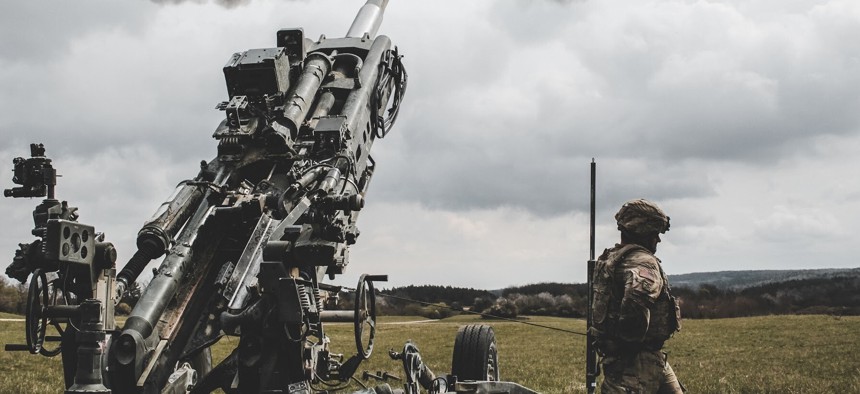
US Army soldiers in the field. DOD
Afghanistan, Iraq Drawdowns Cut $3.2B From US Army Costs, Officials Say
2022 spending request would shrink service budget by a total of $3.6 billion.
The U.S. Army would get $173.0 billion under the Pentagon’s fiscal 2022 budget request, down from the $176.6 billion it received in the current fiscal year, according to its budget documents.
If inflation stays at 4 percent, that would mean a real decrease of about 6 percent — a steeper real decline than in the overall defense budget request, which at $715 billion would decline about 3 percent in real terms from the current year.
Army officials have spread the cuts across their various funding buckets. (The following figures are given in then-year dollars, which do not account for inflation.) For operations and maintenance, the Army is asking for $65.5 billion, a 1.1% reduction from $66.2 billion it received in 2021. The Army is requesting $66.2 billion for personnel, a 1.8% increase from the $65.0 billion appropriated in 2021. And for procurement, the Army wants $21.3 billion, a 11.6% reduction from the $24.1 billion appropriated in 2021.
The Pentagon’s overall research development test and evaluation request is for $112 billion, the highest ever. Of that, the Army is asking for $12.8 billion, a 9.2% cut from the $14.1 billion appropriated in 2021.
On Thursday, Defense Secretary Lloyd Austin and Chairman of the Joint Chiefs of Staff Gen. Mark Milley told Congressional leaders that they did not try to make the Army the “billpayer” for modernization efforts in the Navy and the Air Force.
“The Army's not going to get shortchanged, in my view,” Milley said. “I've looked at this budget very closely, along with Gen. [James] McConville and others. I think it's very balanced amongst all the services and develops their future capabilities. The Big Six at the Army is developing for their modernization program…all of those systems in their Big Six priorities are all being very well funded in this budget.”
The 2022 budget aims to move funds “towards where they're needed for the joint course writ large,” said a senior defense official Thursday. “In some cases, the Army got some new things that they wouldn't have had because of that same divestment. Same thing as the Navy. It went more by domains.”
These joint capabilities include hypersonic weapons, which the Army and the Navy are working on together, and gaining “joint all domain command control investments in sensor to shooter architecture,” said a defense official.
President Joe Biden’s decision to withdraw from Afghanistan means the Navy and Air Force need more money and the Army less, according to senior defense officials.
This budget is the first since 2011 that will not be limited by the Budget Control Act of 2011. Pentagon officials, who had long circumvented the budget caps by moving billions of dollars through the “emergency” Overseas Contingency Operations fund, are now requesting funds for wars and contingencies in the main, or base, budget.
The Iraq and Afghanistan wars had weighed most heavily on Army coffers and the withdrawals will “substantially” reduce the financial burden on the service, defense official said Thursday. Indeed, Austin said the same day, the drawdowns create opportunities for the Army.
The Army will see a $3.2 billion decrease in costs in operation and maintenance funds due to the Iraq and Afghanistan drawdowns. The budget still asks for $3.3 billion in operational support to sustain the Afghanistan Security Forces, a 9.2% increase from 2021. Pentagon officials have said that the United States would still support Afghanistan through financial means, not boots on the grounds.
The Army in 2022 will have a total end strength of just over 1 million soldiers, including 485,000 active duty, 336,000 National Guard, and 189,500 in the Army Reserve. Despite previous desires to grow the active force up to 550,000, Army Chief McConville and former acting Army Secretary John Whitley stated that the service would not exceed their current force levels due to the tight budget.
Soldiers will see a 2.7% base pay raise, a 3.1% increase in their housing allowance, and a 2.3% increase in their basic subsistence allowance.
The 2022 budget request asks for about $11.3 billion for the Army’s modernization strategy, up 18.6% from $9.5 billion in 2021. The Army’s main modernization priorities — their Big Six — are: long-range precision fires, the next-generation combat vehicle, future vertical lift, the network, air-and-missile defense and soldier lethality.
Two of the most discussed priorities are the long-range precision fires and the future vertical lift. The Army wants $1.5 billion for precision fires, up 1.64% from 2021, and $1.6 billion for vertical lift, up 38% from 2021.
In procurement, the Army wants to spend $981 million on upgrading 70 M1A1 Abrams tanks to the M1A2 configuration, which includes improved tank and crew survivability, night vision, and computers.
The Army also wants to spend $854 million on its Integrated Visual Augmented System goggles, or IVAS, which increases situational awareness for soldiers during operations.
Over the past few years, service leaders have trimmed or eliminated various programs to put money elsewhere. In 2020, the Army is asking to shift $47.8 million by eliminating seven programs, including the Hellfire missile launcher, the multi-function electronic warfare program, and the lightweight counter mortar radar.




